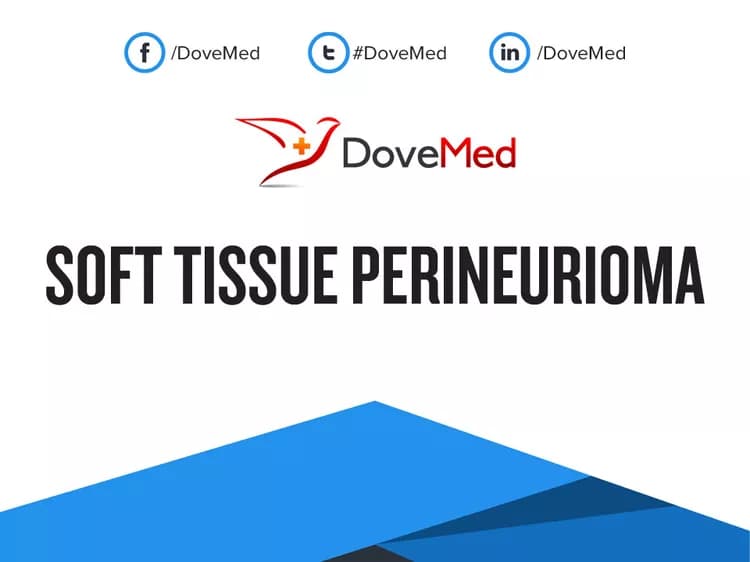What are the other Names for this Condition? (Also known as/Synonyms)
- Extraneural Perineurioma
- Perineurioma of the Soft Tissue
What is Soft Tissue Perineurioma? (Definition/Background Information)
- Perineurioma is a rare tumor of the perineurial cells, a type of cells that are present around a peripheral nerve sheath
- These tumors are generally benign in nature, but may be occasionally malignant. Perineuriomas can occur at a superficial location (underneath the skin), or they may be deep-seated (affecting various internal organs)
- There are 3 different types of Perineuriomas, namely:
- Intraneural Perineurioma: The tumor grows along the nerve; most commonly in the peripheral nerves of the arms and legs
- Soft Tissue Perineurioma: When the tumor does not grow along the nerve, but instead, grows into the soft tissues surrounding a nerve, they are called Soft Tissue Perineuriomas. These tumors may be present at any location in the body
- Malignant Perineurioma: It is the malignant transformation of a Perineurioma that can either be the intraneural type or soft tissue type
- There are no identified risk factors or causative factors for Soft Tissue Perineurioma, though certain chromosomal abnormalities have been observed
- In a majority of cases, Soft Tissue Perineuriomas may present no signs and symptoms. And, these tumors may be only incidentally discovered, while performing radiological studies for other health reasons
- If the tumors are asymptomatic, then no treatment may be necessary. In these cases, a ‘wait and watch’ approach may be adopted by the healthcare provider. If required, a complete surgical excision of the Soft Tissue Perineurioma is performed
- The prognosis is generally excellent for small tumors that are easily removed, since these tumors are generally benign
Who gets Soft Tissue Perineurioma? (Age and Sex Distribution)
- Soft Tissue Perineurioma usually occurs in adults
- Both females and males are affected, although females are affected more than males
- There is no racial or ethnic preference observed; the tumors are seen worldwide in men and women
What are the Risk Factors for Soft Tissue Perineurioma? (Predisposing Factors)
- The risk factors for Soft Tissue Perineurioma are currently unknown or unidentified
It is important to note that having a risk factor does not mean that one will get the condition. A risk factor increases ones chances of getting a condition compared to an individual without the risk factors. Some risk factors are more important than others.
Also, not having a risk factor does not mean that an individual will not get the condition. It is always important to discuss the effect of risk factors with your healthcare provider.
What are the Causes of Soft Tissue Perineurioma? (Etiology)
- The exact cause of Soft Tissue Perineurioma formation and development is unknown
- Studies have shown chromosomal abnormalities on chromosome 22 (monosomy of chromosome 22)
What are the Signs and Symptoms of Soft Tissue Perineurioma?
The signs and symptoms of Soft Tissue Perineurioma depend on the location of the tumor. It may include:
- Normally, these are well-circumscribed, small, solitary tumors that do not cause any significant signs and symptoms
- They are usually small, but may range in size between 1-12 cm
- Pain in the affected region
- It may be observed at any location in the body
How is Soft Tissue Perineurioma Diagnosed?
Soft Tissue Perineurioma is diagnosed using the following tools:
- Complete physical examination with comprehensive evaluation of medical history
- Radiographic studies of the affected region
- Tissue biopsy: A tissue biopsy is performed and sent to a laboratory for a pathological examination. The pathologist examines the biopsy under a microscope. After putting together clinical findings, special studies on tissues (if needed) and with microscope findings, the pathologist arrives at a definitive diagnosis. The biopsy is generally performed to rule out other more severe conditions
Note: Even though Soft Tissue Perineuriomas are typically benign, biopsies are performed for diagnostic purposes to rule out other serious tumors.
Many clinical conditions may have similar signs and symptoms. Your healthcare provider may perform additional tests to rule out other clinical conditions to arrive at a definitive diagnosis.
What are the possible Complications of Soft Tissue Perineurioma?
There are no significant complications due to Soft Tissue Perineurioma; however, some tumors may turn malignant.
How is Soft Tissue Perineurioma Treated?
Treatment measures for Soft Tissue Perineurioma may include the following:
- If there are no symptoms, then periodic observation is maintained. If there is any pain, it can be controlled through pain medication
- Surgical excision with removal of the entire tumor is undertaken, if the symptoms are severe. This is normally curative. A surgery may not be usually performed in many cases, since the risks for surgery may far outweigh the benefits
- Post-operative care is important: One must maintain minimum activity levels, until the surgical wound heals
- Post-operative follow-up care with regular screening and check-ups are important
How can Soft Tissue Perineurioma be Prevented?
Current medical research has not established a way of preventing Soft Tissue Perineurioma.
What is the Prognosis of Soft Tissue Perineurioma? (Outcomes/Resolutions)
- In many cases, Soft Tissue Perineuriomas are asymptomatic and these tumors may not require any treatment. However, the healthcare provider may undertake regular monitoring of the tumor, which is important
- The prognosis is generally excellent, when the tumors are small and are completely excised
Additional and Relevant Useful Information for Soft Tissue Perineurioma:
A differential diagnosis may be considered to eliminate the following conditions:
- Neurofibroma
- Dermatofibroma
- Neurothekeoma
Related Articles
Test Your Knowledge
Asked by users
Related Centers
Related Specialties
Related Physicians
Related Procedures
Related Resources
Join DoveHubs
and connect with fellow professionals


0 Comments
Please log in to post a comment.